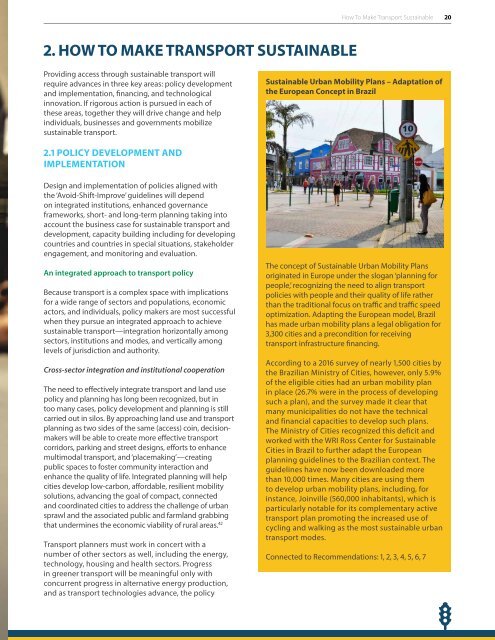MOBILIZING DEVELOPMENT
a5OQ306q56U
a5OQ306q56U
You also want an ePaper? Increase the reach of your titles
YUMPU automatically turns print PDFs into web optimized ePapers that Google loves.
How To Make Transport Sustainable 20<br />
2. HOW TO MAKE TRANSPORT SUSTAINABLE<br />
Providing access through sustainable transport will<br />
require advances in three key areas: policy development<br />
and implementation, financing, and technological<br />
innovation. If rigorous action is pursued in each of<br />
these areas, together they will drive change and help<br />
individuals, businesses and governments mobilize<br />
sustainable transport.<br />
Sustainable Urban Mobility Plans – Adaptation of<br />
the European Concept in Brazil<br />
2.1 POLICY <strong>DEVELOPMENT</strong> AND<br />
IMPLEMENTATION<br />
Design and implementation of policies aligned with<br />
the ‘Avoid-Shift-Improve’ guidelines will depend<br />
on integrated institutions, enhanced governance<br />
frameworks, short- and long-term planning taking into<br />
account the business case for sustainable transport and<br />
development, capacity building including for developing<br />
countries and countries in special situations, stakeholder<br />
engagement, and monitoring and evaluation.<br />
An integrated approach to transport policy<br />
Because transport is a complex space with implications<br />
for a wide range of sectors and populations, economic<br />
actors, and individuals, policy makers are most successful<br />
when they pursue an integrated approach to achieve<br />
sustainable transport—integration horizontally among<br />
sectors, institutions and modes, and vertically among<br />
levels of jurisdiction and authority.<br />
Cross-sector integration and institutional cooperation<br />
The need to effectively integrate transport and land use<br />
policy and planning has long been recognized, but in<br />
too many cases, policy development and planning is still<br />
carried out in silos. By approaching land use and transport<br />
planning as two sides of the same (access) coin, decisionmakers<br />
will be able to create more effective transport<br />
corridors, parking and street designs, efforts to enhance<br />
multimodal transport, and ‘placemaking’—creating<br />
public spaces to foster community interaction and<br />
enhance the quality of life. Integrated planning will help<br />
cities develop low-carbon, affordable, resilient mobility<br />
solutions, advancing the goal of compact, connected<br />
and coordinated cities to address the challenge of urban<br />
sprawl and the associated public and farmland grabbing<br />
that undermines the economic viability of rural areas. 42<br />
Transport planners must work in concert with a<br />
number of other sectors as well, including the energy,<br />
technology, housing and health sectors. Progress<br />
in greener transport will be meaningful only with<br />
concurrent progress in alternative energy production,<br />
and as transport technologies advance, the policy<br />
The concept of Sustainable Urban Mobility Plans<br />
originated in Europe under the slogan ‘planning for<br />
people,’ recognizing the need to align transport<br />
policies with people and their quality of life rather<br />
than the traditional focus on traffic and traffic speed<br />
optimization. Adapting the European model, Brazil<br />
has made urban mobility plans a legal obligation for<br />
3,300 cities and a precondition for receiving<br />
transport infrastructure financing.<br />
According to a 2016 survey of nearly 1,500 cities by<br />
the Brazilian Ministry of Cities, however, only 5.9%<br />
of the eligible cities had an urban mobility plan<br />
in place (26.7% were in the process of developing<br />
such a plan), and the survey made it clear that<br />
many municipalities do not have the technical<br />
and financial capacities to develop such plans.<br />
The Ministry of Cities recognized this deficit and<br />
worked with the WRI Ross Center for Sustainable<br />
Cities in Brazil to further adapt the European<br />
planning guidelines to the Brazilian context. The<br />
guidelines have now been downloaded more<br />
than 10,000 times. Many cities are using them<br />
to develop urban mobility plans, including, for<br />
instance, Joinville (560,000 inhabitants), which is<br />
particularly notable for its complementary active<br />
transport plan promoting the increased use of<br />
cycling and walking as the most sustainable urban<br />
transport modes.<br />
Connected to Recommendations: 1, 2, 3, 4, 5, 6, 7


